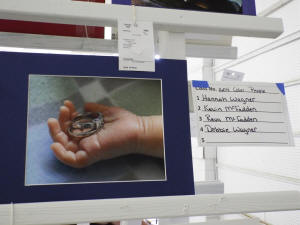|
 The two classes of photos are black and white
prints and color prints and there are several categories of each. The two classes of photos are black and white
prints and color prints and there are several categories of each.
Categories of black and white prints include abstract, design, or
still life; animal, architectural/historical; water, scenery, human
interest, and photos of people.
Categories of color prints also include the abstract, design, or
still life; animal, architectural/historical, water, scenery, human
interest, people, floral, sunset, computer altered, sports, and
photos that are echoes of Abraham Lincoln.
Photography Department Superintendent Stephen Klemm and his
assistant Megan Haines shared what makes for a winning photo, what
he looks for in a photo, what people can do to take a good photo and
participate in fair photography contests, and how photography has
changed over the years.

Klemm started as a hobbyist and then became a professional. He looks
for photos taken by hobbyists who take photos because they love to
do it.
Klemm said the impact and first impression of a photo are very
important to him. The photos should follow certain guidelines or
rules such as showing color contrast, harmony, pattern and the rule
of thirds.
Haines said presentation and whether it looks nice is important
because the presentation of a print makes it stand out. A photo will
do well if it is presented on a nice mount board rather than just
pasted on cardboard.
Klemm said people still interested in the art side of photos tend to
do well. He said sometimes it seems the art of photography is being
lost.

As for contrast with black and white photos, Haines
said high contrast is blacker and whiter in a photo, while low
contrast has shades of gray.
Both Klemm and Haines have suggestions for ways to get a good photo.
One is to bend your knees when taking a photo. Get on eye level or
on different levels. For instance, climbing a ladder or taking a
photo from below can provide interesting angles. Haines said
different angles can give you a completely different picture than if
you are just standing straight up.
Klemm said it is also important to know the direction of the light
and use the light to “paint” with.

[to top of second column] |
 Watching what is in the background is another
important consideration. Klemm said you do not want a telephone pole
or a tree “growing” out of somebody’s head.
Haines said knowing how to use the camera
correctly helps. Many people do not open their user manual that can
tell them so many special features to use.
Klemm and Haines have seen many changes in photography over the
years. For instance, Haines said it has gotten a lot easier for the
public to take photos and camera phones have made photography
something that is a part of everyday life. She said you take a
selfie with the Statue of Liberty in the background, you are marking
your life.
Klemm said using no more chemicals or processing
is a big change, and it is now easier to take a photo. Since they
can be taken with phones, drones, pocket cameras, or Digital Single
Len Reflex (DLSR) cameras.
Haines said the instant viewing with digital cameras is helpful for
photographers since you can easily delete a photo you don’t like.
Klemm said cameras are now faster. Many can take videos, and taking
a video and freezing one frame of it can make for a good photo.
What makes for a good subject?

Haines said good human-interest photos can provide
something that interests everyone. Klemm said it is something that
makes you stop and think. Haines gave an example from last year’s
entries. One entry was of a Yahtzee game where someone had just
rolled a ‘Yahtzee,’ and the game pieces and different expressions on
people’s faces made it an interesting photo and showed it was a fun
game night.
 Haines said with abstracts, you
cannot always initially tell what the photo is of. It may be an
intricate pattern or close-up of something such as part of a tire,
rocks, or lamp. Klemm said he likes to see something out of the
ordinary when looking at abstracts.
According to Klemm there are 301 photos entered this year. Depending
on the year, there are usually between 300 and 400 entries.
As entries came in, it appeared there were many great photos to
choose from. You can check-out the winning entries in the expo
building.
[Angela Reiners] |